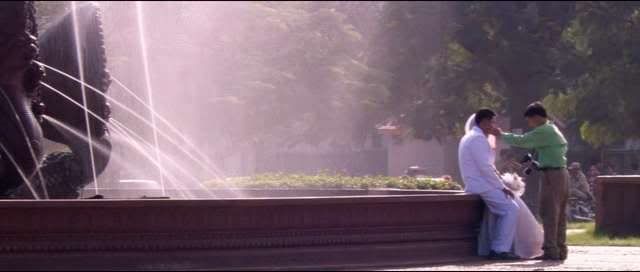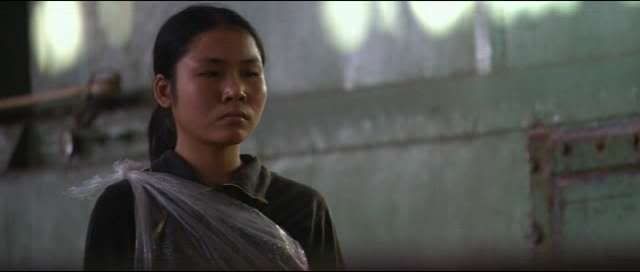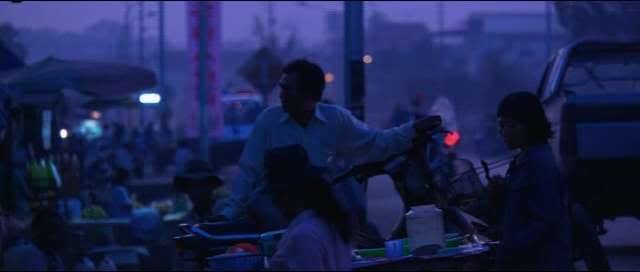
Patrice Leconte probably couldn't make a conventional film if he wanted to, which he obviously doesn't. That in itself doesn't distinguish him especially — practically every indie director aspires to be more "out there" than the other boundary pushers — but Leconte adds brains, and often heart, to the mix. None of his films I've seen follow a tested formula. I'm especially fond of The Hairdresser's Husband and The Girl on the Bridge, offbeat and touching modern romances.
Dogora was released in Europe in 2004. It is now making its debut in the U.S. on DVD. It's a pure visual and auditory experience that consists almost entirely of scenes of daily life in Cambodia, and you probably wouldn't even know the exact location if you didn't read about it. No dialogue, no narration, no captioning. And no political posturing. You can draw your own conclusions from what you see, without a narrator hectoring you about environmental damage or interviews of carefully selected Cambodians telling you they're hard done by, as there would be if this were a PBS or BBC program.
Artistically, a film that deliberately limits itself to sights and sounds (mostly music) is taking a risk because there's no overt drama. (The French poster has the subhead, "Ouvrons les yeux" — let's open our eyes.) Dogora's obvious model is the 1982 film Koyaanisqatsi, much praised for its images showing "life out of balance," which is what the title signifies in the Hopi language. I was originally impressed with Koyaanisqatsi too, but less on subsequent viewings, although that may be partly because the novelty has worn off. But the "message" aspect also became annoying, and Philip Glass's musical score, although an asset, now sounds pretty much like every other he's done since.
Dogora's lack of an ideological theme is a virtue, but a negative one. A sense-experience film needs to have positives going for it as well. Dogora does.
The cinematography, by Jean-Marie Dreujou, offers much pleasure. He varies the tonalities with filters, creating moody lighting effects, and often goes with a slightly oversaturated color palette (not a criticism; it's a legitimate artistic technique).
Everyone will find their own memorable images. Here are a few of mine. A children's playground, multi-colored balloons in the foreground, an animal — perhaps a water buffalo, I'm not sure — casually wandering through the frame. Fishing boats in the twilight (or made to seem like in the twilight), the shot suffused with gradations of blue, accented by delicate salmon-pink wisps of clouds. Buddhist monks, deliberately filmed out of focus, gliding like ghosts in their nasturtium-orange robes.
We see lots of Cambodians — young, old, in-between — in close-up or medium close-up. They are, on the whole, an attractive people, the faces slightly rounded, noses gently sloping, prominent cheekbones. They appear to carry themselves with considerable dignity, even when forced to do undignified things. The younger generations don't remember the horrors of the Pol Pot regime, although anyone over 50 certainly does, and it's admirable that the culture appears to have held together and avoided further psychopathology.
But the movie, to Leconte's credit, isn't just eye candy. He shows everyday life — storekeeping, factory jobs, riding motor scooters — but also ugly and disturbing scenes. We see a large group, including children, scavenging in a trash dump as bulldozers chug around them. We see the grungy, meager accompaniments of poverty, ghastly slum housing. Lots of the Cambodians have their mouths covered, some with surgical masks, many with scarves. Why? Is the air that polluted, like in China?
The images are not an unmixed blessing. Even at a relatively short 80 minutes, there is footage that could have been cut to the film's advantage. People washing cars, riding in pickup trucks, staring at the camera, and doing common things occupy too much of Dogora. Editing and music don't necessarily make routine actions fascinating.
The musical score is very odd. It's performed by a Western orchestra, with a vocal chorus, which for some reason lost on me is shown (using black and white film) performing in a concert hall at the film's beginning and end. The music has no Cambodian influence that I can detect (maybe the sung language is Cambodian), rather a Slavic spiciness. Although there are restrained lyrical interludes, a good deal of the writing is muscular and rhythmic. Think of a World War II victory anthem by a third-rate Soviet composer and you have the idea.
But despite occasional missteps and draggy bits, Dogora is more than the sum of its parts. It is a revealing portrait of a culture that is probably as un-Westernized as anyplace in Asia, full of sights that will be exotic and occasionally unsettling to most Americans. Impressionism in painting dazzled the art world in the late 19th century, and its cinematic equivalent could become equally influential in our own time. Dogora may not make the greatest possible use of its own style, but it's more sophisticated and less tendentious than Koyaanisqatsi. Once again, adventurous audiences have reason to thank Patrice Leconte.
Disclosure: The organization publicizing Dogora's U.S. release supplied me with a "screener" DVD and background material.
Dogora was released in Europe in 2004. It is now making its debut in the U.S. on DVD. It's a pure visual and auditory experience that consists almost entirely of scenes of daily life in Cambodia, and you probably wouldn't even know the exact location if you didn't read about it. No dialogue, no narration, no captioning. And no political posturing. You can draw your own conclusions from what you see, without a narrator hectoring you about environmental damage or interviews of carefully selected Cambodians telling you they're hard done by, as there would be if this were a PBS or BBC program.
Artistically, a film that deliberately limits itself to sights and sounds (mostly music) is taking a risk because there's no overt drama. (The French poster has the subhead, "Ouvrons les yeux" — let's open our eyes.) Dogora's obvious model is the 1982 film Koyaanisqatsi, much praised for its images showing "life out of balance," which is what the title signifies in the Hopi language. I was originally impressed with Koyaanisqatsi too, but less on subsequent viewings, although that may be partly because the novelty has worn off. But the "message" aspect also became annoying, and Philip Glass's musical score, although an asset, now sounds pretty much like every other he's done since.
Dogora's lack of an ideological theme is a virtue, but a negative one. A sense-experience film needs to have positives going for it as well. Dogora does.
The cinematography, by Jean-Marie Dreujou, offers much pleasure. He varies the tonalities with filters, creating moody lighting effects, and often goes with a slightly oversaturated color palette (not a criticism; it's a legitimate artistic technique).
Everyone will find their own memorable images. Here are a few of mine. A children's playground, multi-colored balloons in the foreground, an animal — perhaps a water buffalo, I'm not sure — casually wandering through the frame. Fishing boats in the twilight (or made to seem like in the twilight), the shot suffused with gradations of blue, accented by delicate salmon-pink wisps of clouds. Buddhist monks, deliberately filmed out of focus, gliding like ghosts in their nasturtium-orange robes.
We see lots of Cambodians — young, old, in-between — in close-up or medium close-up. They are, on the whole, an attractive people, the faces slightly rounded, noses gently sloping, prominent cheekbones. They appear to carry themselves with considerable dignity, even when forced to do undignified things. The younger generations don't remember the horrors of the Pol Pot regime, although anyone over 50 certainly does, and it's admirable that the culture appears to have held together and avoided further psychopathology.
But the movie, to Leconte's credit, isn't just eye candy. He shows everyday life — storekeeping, factory jobs, riding motor scooters — but also ugly and disturbing scenes. We see a large group, including children, scavenging in a trash dump as bulldozers chug around them. We see the grungy, meager accompaniments of poverty, ghastly slum housing. Lots of the Cambodians have their mouths covered, some with surgical masks, many with scarves. Why? Is the air that polluted, like in China?
The images are not an unmixed blessing. Even at a relatively short 80 minutes, there is footage that could have been cut to the film's advantage. People washing cars, riding in pickup trucks, staring at the camera, and doing common things occupy too much of Dogora. Editing and music don't necessarily make routine actions fascinating.
The musical score is very odd. It's performed by a Western orchestra, with a vocal chorus, which for some reason lost on me is shown (using black and white film) performing in a concert hall at the film's beginning and end. The music has no Cambodian influence that I can detect (maybe the sung language is Cambodian), rather a Slavic spiciness. Although there are restrained lyrical interludes, a good deal of the writing is muscular and rhythmic. Think of a World War II victory anthem by a third-rate Soviet composer and you have the idea.
But despite occasional missteps and draggy bits, Dogora is more than the sum of its parts. It is a revealing portrait of a culture that is probably as un-Westernized as anyplace in Asia, full of sights that will be exotic and occasionally unsettling to most Americans. Impressionism in painting dazzled the art world in the late 19th century, and its cinematic equivalent could become equally influential in our own time. Dogora may not make the greatest possible use of its own style, but it's more sophisticated and less tendentious than Koyaanisqatsi. Once again, adventurous audiences have reason to thank Patrice Leconte.
Disclosure: The organization publicizing Dogora's U.S. release supplied me with a "screener" DVD and background material.






No comments:
Post a Comment